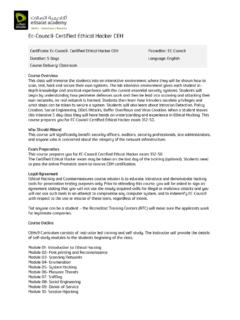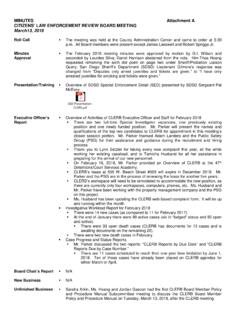Transcription of Session Fixation Vulnerability in Web-based …
1 PUBLIC Session Fixation Vulnerability in Web-based Applications 2002 ACROS [ ] page 1 of 16 Session Fixation Vulnerability in Web-based Applications Version revision 1 Mitja Kol ek ACROS Security December 2002 (Revised February 2007 the Acknowledgments section) Current copy available at 1. Abstract Many Web-based applications employ some kind of Session management to create a user-friendly environment. sessions are stored on server and associated with respective users by Session identifiers (IDs). Naturally, Session IDs present an attractive target for attackers, who, by obtaining them, effectively hijack users identities.
2 Knowing that, web servers are employing techniques for protecting Session IDs from three classes of attacks: interception, prediction and brute-force attacks. This paper reveals a fourth class of attacks against Session IDs: Session Fixation attacks. In a Session Fixation attack, the attacker fixes the user s Session ID before the user even logs into the target server, thereby eliminating the need to obtain the user s Session ID afterwards. There are many ways for the attacker to perform a Session Fixation attack, depending on the Session ID transport mechanism (URL arguments, hidden form fields, cookies) and the vulnerabilities available in the target system or its immediate environment.
3 The paper provides detailed information about exploiting vulnerable systems as well as recommendations for protecting them against Session Fixation attacks. 2. Introduction Web-based applications frequently use sessions to provide a friendly environment to their users. HTTP [1] is a stateless protocol, which means that it provides no integrated way for a web server to maintain states throughout user s subsequent requests. In order to overcome this problem, web servers or sometimes web applications implement various kinds of Session management. The basic idea behind web Session management is that the server generates a Session identifier (ID) at some early point in user interaction, sends this ID to the user s browser and makes sure that this same ID will be sent back by the browser along with each subsequent request.
4 Session IDs thereby become identification tokens for users, and servers can PUBLIC Session Fixation Vulnerability in Web-based Applications 2002 ACROS [ ] page 2 of 16 use them to maintain Session data ( , variables) and create a Session -like experience to the users. There are three widely used methods for maintaining sessions in web environment: URL arguments, hidden form fields and cookies [2]. While each of them has its benefits and shortcomings, cookies have proven to be the most convenient and also the least insecure of the three. From security perspective, most if not all - known attacks against cookie-based Session maintenance schemes can also be used against URL- or hidden form fields-based schemes, while the converse is not true.
5 This makes cookies the best choice security-wise. Very often, Session IDs are not only identification tokens, but also authenticators. This means that upon login, users are authenticated based on their credentials ( , usernames/passwords or digital certificates) and issued Session IDs that will effectively serve as temporary static passwords for accessing their sessions . This makes Session IDs a very appealing target for attackers. In many cases, an attacker who manages to obtain a valid ID of user s Session can use it to directly enter that Session often without arising user s suspicion. Interestingly, most cross-site scripting [3] proof-of-concept exploits focus on obtaining the Session ID stored in browser s cookie storage.
6 This class of attacks, where the attacker gains access to the user s Session by obtaining his Session ID, is called Session hijacking [4]. Web Session security is focused on preventing three types of attacks against Session IDs: interception, prediction and brute-force attacks. Encrypted communication effectively protects against interception1. Using cryptographically strong pseudo-random number generators and carefully chosen seeds that don t leak from the server prevents prediction of Session IDs. Finally, Session IDs are immune to brute-force methods if their effective bit-length is large enough with respect to the number of simultaneous have been made for mitigating the threat of stolen Session IDs [6], and some products already implement such ideas ( , RSA Security s ACE/Agents for web servers).
7 3. Session Fixation As mentioned above, web Session security is mainly focused on preventing the attacker from obtaining either intercepting, predicting or brute-forcing - a Session ID issued by the web server (also called target server in this paper) to the user s browser. This approach, however, ignores one possibility: namely the possibility of the attacker issuing a Session ID to the user s browser, thereby forcing the browser into using a chosen Session . We ll call this class of attacks Session Fixation attacks, because the user s Session ID has been fixed in advance instead of having been generated randomly at login time.
8 1 Although forgetting to mark Session ID cookies as secure keeps the attacker's foot in the door [7]. 2 David Endler of iDefense wrote a very interesting article [5] on this topic. PUBLIC Session Fixation Vulnerability in Web-based Applications 2002 ACROS [ ] page 3 of 16 In a Session Fixation attack, the attacker fixes the user s Session ID before the user even logs into the target server, thereby eliminating the need to obtain the user s Session ID afterwards. Let s take a look at a simple example of a Session Fixation attack. Figure 1 shows a web server that hosts a Session -aware web banking application.
9 Session IDs are transported from browser to server within a URL argument , the attacker who in this case is also a legitimate user of the system logs in to the server (1) and is issued a Session ID 1234 (2). She then sends a hyperlink to the user, trying to lure him into clicking on it (3). The user (how convenient for our example) clicks on the link, which opens the server s login page in his browser (4). Note that upon receipt of the request for , the web application has established that a Session already exists for this user and a new one need not be created. Finally, the user provides his credentials to the login script (5) and the server grants him access to his bank account.
10 However, at this point, knowing the Session ID, the attacker can also access the user s account via (6). Since the Session has already been fixed before the user logged in, we say that the user logged into the attacker s & password5 Figure 1: Simple Session Fixation in an URL-based web banking system The above example is the simplest and the least dangerous - form of a Session Fixation attack and has many shortcomings (for the attacker), such as: she has to be a PUBLIC Session Fixation Vulnerability in Web-based Applications 2002 ACROS [ ] page 4 of 16 legitimate user on the target server and she has to trick the user into logging in through the hyperlink she provided.




